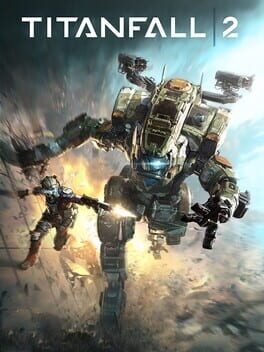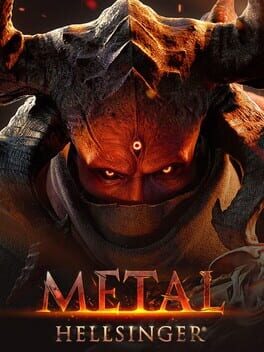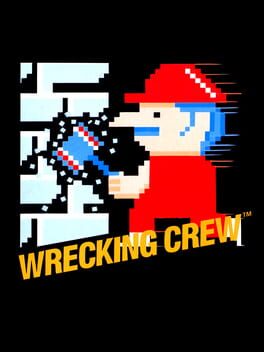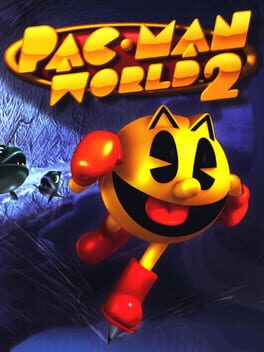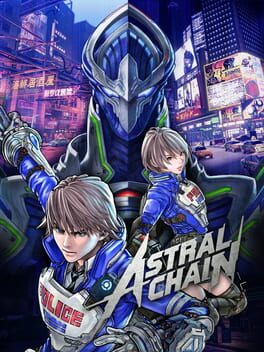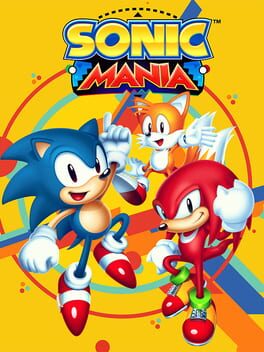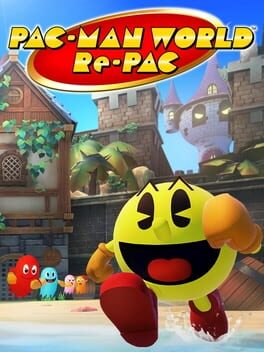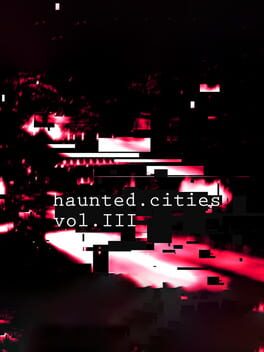Conger_Conger
18 reviews liked by Conger_Conger
Titanfall 2
2016
Thanks Azumarrill for the recommendation.
Titanfall 2 is one of the best shooters that I have played in recent years. I have always heard good things about it but I did not expect to enjoy it this much.
The campaign is short and can be completed in an afternoon. However, they still managed to cram so much in it. There are so many interesting mechanics introduced throughout the game that help keep the gameplay fresh. I do not want to spoil anything but one level genuinely shocked me with how crazy it was.
I can see now how Titanfall had such an impact on shooters at the time. I can't believe it's taken me this long to play it. Hopefully we will see more Titanfall games in the future.
Titanfall 2 is one of the best shooters that I have played in recent years. I have always heard good things about it but I did not expect to enjoy it this much.
The campaign is short and can be completed in an afternoon. However, they still managed to cram so much in it. There are so many interesting mechanics introduced throughout the game that help keep the gameplay fresh. I do not want to spoil anything but one level genuinely shocked me with how crazy it was.
I can see now how Titanfall had such an impact on shooters at the time. I can't believe it's taken me this long to play it. Hopefully we will see more Titanfall games in the future.
Metal: Hellsinger
2022
Have you ever looked at an album’s cover art and wished that, somehow, you could play it? Do you gain much satisfaction from a well-timed button press and/or chasing high scores? Did you grow up watching Scuzz? Metal: Hellsinger was made for you if your answer to any one of those questions is yes, but even if these don’t apply, you should play it anyway. Fast-paced, old school FPSs have had among the strongest resurgences any kind of game’s ever had, but even the most boisterous of those feel tame after you’ve experienced one that’s been beautifully blended with a rhythm game.
It’s unreal how much the seemingly simple addition of having to stay in rhythm adds to this sort of formula. Chaining perfectly timed dashes, shots, reloads and slaughters one after the other as Matt Heafy or Serj Tankian or whoever else begins to progressively batter your eardrums isn’t just bound to make you involuntarily grin, it’s also an example of how Hellsinger trumps one of its influences. Slaughters are analogous to Doom’s glory kills, which I’d argue were already outdone by WH40K: Space Marine’s executions five years prior, but Hellsinger takes a step further and makes this kind of mechanic more cohesive than ever. You have to properly time slaughters the same way you do virtually every other action in the game or else your score streak goes kaput, and you can’t rely too heavily on the brief invincibility they give you since they don’t prevent your fury (i.e. your score multiplier) from going down. We have risk, we have reward, and they’re implemented in such a way that they add to Hellsinger’s enthralling flow rather than disrupting it, thanks to small but constant tests of timing and prioritisation.
The rhythm informs much of Hellsinger’s visual design, too. I especially love how light sources (including certain enemies) flash along to the beat, eventually turning into streams of fire you’d see at a concert once your fury gets high enough. It’s not just window dressing, either. In such an active, hectic game where so many things are going on at once, it’s immensely helpful to have indicators of how well you’re doing implemented diegetically into the environment, serving a similar function to Patapon’s (also clever) light bar. The environments themselves complement the Unknown’s movement abilities well, offering you plenty of ways to zip all over the show and gradually increasing in complexity over the course of the game’s short runtime to form a well-balanced difficulty curve in tandem with new, increasingly manoeuvrable enemies being thrown at you in each level. It might’ve been good to have varied the bosses’ appearances more, but their attack patterns and arenas are each distinct enough functionally speaking that they remain entertaining throughout.
As far Hellsinger’s story goes, much of the criticism it seems to be receiving on here strikes me as being overly concerned with the what rather than the how. Is there a better way is there to tell a tale in a game like this than via song lyrics which only kick in once you’re playing well enough, alternate between the perspectives of the three main characters and finally culminate in a remix of the main menu theme? This is the kind of thing that’s exclusively possible within this medium, accomplishing which I’d say pretty vastly outweighs whether or not the (entirely skippable) cutscenes are to your taste. The narrative’s primarily here to make you feel unstoppable with some brief moments of levity sprinkled in through Paz, as if you were playing an interactive version of Judas Priest’s Painkiller or Brothers of Metal’s Chain Breaker, and it’s a total success in that respect.
If you’ve been listening to metal for most of your life like I have, I should also hope you’re aware of just how many concept albums out there are comprised of the most broken of broken English. Few would doubt the quality of Avantasia’s discography, for instance, but I imagine equally few could tell you off the top of their head what half of their songs are about. I bring this up both because people seem to lack a frame of reference for how comprehensible Hellsinger’s writing is compared to much of what it’s a love letter to, and also to illustrate the point that content is secondary to how that content is delivered. Put another way: it’s not what you say, but how you say it, and Hellsinger says it with an appropriate helping of tongue-in-cheek which lends it the same charisma as other great odes to the genre like Metalocalypse.
No doubt, the fruit of saying “the soundtrack is good” hangs so low it’s on the ground, but I’m saying it anyway. You could release it standalone and it’d pass for a high quality album, though listening to it (and the excellence that is Stygia in particular) in a vacuum just isn’t the same without shotgun blasts and demonic wing flaps pulsating in the background.
Hence why you should play Metal: Hellsinger. It’s around five hours of pure unadulterated joy, and more than that if you’re into games like Hotline Miami where you can easily pass an afternoon chasing higher scores. The fact that the Unknown has what is probably the coolest design for any protagonist in the past decade or so is just a bonus. Do it for her.
It’s unreal how much the seemingly simple addition of having to stay in rhythm adds to this sort of formula. Chaining perfectly timed dashes, shots, reloads and slaughters one after the other as Matt Heafy or Serj Tankian or whoever else begins to progressively batter your eardrums isn’t just bound to make you involuntarily grin, it’s also an example of how Hellsinger trumps one of its influences. Slaughters are analogous to Doom’s glory kills, which I’d argue were already outdone by WH40K: Space Marine’s executions five years prior, but Hellsinger takes a step further and makes this kind of mechanic more cohesive than ever. You have to properly time slaughters the same way you do virtually every other action in the game or else your score streak goes kaput, and you can’t rely too heavily on the brief invincibility they give you since they don’t prevent your fury (i.e. your score multiplier) from going down. We have risk, we have reward, and they’re implemented in such a way that they add to Hellsinger’s enthralling flow rather than disrupting it, thanks to small but constant tests of timing and prioritisation.
The rhythm informs much of Hellsinger’s visual design, too. I especially love how light sources (including certain enemies) flash along to the beat, eventually turning into streams of fire you’d see at a concert once your fury gets high enough. It’s not just window dressing, either. In such an active, hectic game where so many things are going on at once, it’s immensely helpful to have indicators of how well you’re doing implemented diegetically into the environment, serving a similar function to Patapon’s (also clever) light bar. The environments themselves complement the Unknown’s movement abilities well, offering you plenty of ways to zip all over the show and gradually increasing in complexity over the course of the game’s short runtime to form a well-balanced difficulty curve in tandem with new, increasingly manoeuvrable enemies being thrown at you in each level. It might’ve been good to have varied the bosses’ appearances more, but their attack patterns and arenas are each distinct enough functionally speaking that they remain entertaining throughout.
As far Hellsinger’s story goes, much of the criticism it seems to be receiving on here strikes me as being overly concerned with the what rather than the how. Is there a better way is there to tell a tale in a game like this than via song lyrics which only kick in once you’re playing well enough, alternate between the perspectives of the three main characters and finally culminate in a remix of the main menu theme? This is the kind of thing that’s exclusively possible within this medium, accomplishing which I’d say pretty vastly outweighs whether or not the (entirely skippable) cutscenes are to your taste. The narrative’s primarily here to make you feel unstoppable with some brief moments of levity sprinkled in through Paz, as if you were playing an interactive version of Judas Priest’s Painkiller or Brothers of Metal’s Chain Breaker, and it’s a total success in that respect.
If you’ve been listening to metal for most of your life like I have, I should also hope you’re aware of just how many concept albums out there are comprised of the most broken of broken English. Few would doubt the quality of Avantasia’s discography, for instance, but I imagine equally few could tell you off the top of their head what half of their songs are about. I bring this up both because people seem to lack a frame of reference for how comprehensible Hellsinger’s writing is compared to much of what it’s a love letter to, and also to illustrate the point that content is secondary to how that content is delivered. Put another way: it’s not what you say, but how you say it, and Hellsinger says it with an appropriate helping of tongue-in-cheek which lends it the same charisma as other great odes to the genre like Metalocalypse.
No doubt, the fruit of saying “the soundtrack is good” hangs so low it’s on the ground, but I’m saying it anyway. You could release it standalone and it’d pass for a high quality album, though listening to it (and the excellence that is Stygia in particular) in a vacuum just isn’t the same without shotgun blasts and demonic wing flaps pulsating in the background.
Hence why you should play Metal: Hellsinger. It’s around five hours of pure unadulterated joy, and more than that if you’re into games like Hotline Miami where you can easily pass an afternoon chasing higher scores. The fact that the Unknown has what is probably the coolest design for any protagonist in the past decade or so is just a bonus. Do it for her.
Wrecking Crew
1985
Some very solid puzzle platforming! Despite the small number of elements, there is a lot of variety in level design. If you were playing this without save states i can see it being really frustrating as I had to rely on a lot of trial and error and precise timing to beat some of the harder levels, and definitely couldn't have done it with the limited lives you're given. But if you're playing this on the Switch you're gonna have a much easier time of it.
Pac-Man World 2
2002
Had a lot of fun at the start. Once I got around half way however, I started to notice its flaws. Crazy difficulty spikes, cheap deaths, a lot of jank and a constant fight with the camera make it a frustrating experience. It's a shame because I really wanted to like this game, sadly its many flaws stopped that from happening.
Also that's not Clyde it's Blinky!
Also that's not Clyde it's Blinky!
Astral Chain
2019
Not least for its sheer creativity and ambition, Astral Chain is a game we’re lucky to have gotten. Given that action games are generally niche as is, it’s difficult to imagine that one which primarily predicates itself on controlling multiple characters at once was an easy pitch, especially considering its development came hot on the heels of Scalebound’s cancellation. The best media is often borne of troubled circumstances, and Astral Chain surely is one of the best, both of Platinum’s catalogue and its genre at large. Tough out its steep learning curve, and beneath initial frustrations, you’ll uncover a rough gem that stands out as being exceedingly rewarding to learn even by the lofty standards of its peers.
Key word, “steep.” The amount of tools you have at your disposal in Astral Chain’s genuinely overwhelming, decision paralysis being about as much of a hurdle for a new player as the ongoing demonic invasion for the Ark’s boys in blue. You’ve wrapped the titular chain around an enemy, incapacitating it for a brief moment. What next? You might whittle it down with one of the Sword Legion’s eco-friendly flurry attacks, but maybe it’d die faster if you expend much more energy to sneak in some headshots with the Arrow Legion. The Arm Legion has the most cost-efficient damage in the business and can even float over hazards, but what if you can’t take advantage of these benefits in time because he’s so slow? Oops, now it’s broken free – parrying its attack with the Axe Legion’s shield would end things fast, but if you can’t afford the risk, you might instead ride the Beast Legion and employ its automatic dodging in exchange for comparatively little reward. Lots of decisions to be made.
This is only taking into consideration the simplest possible situation in the game, too, without regard for the Howard twins’ own arsenal, how every combination of enemies one can think of will eventually be thrown at you by the time you reach the postgame, what’s quite handily some of the most varied combat arenas action games have to offer, or any number of other less obvious techniques you can do. For a bit of perspective, I didn’t learn that you can have more than one Legion out at once until after my first playthrough, which might make it sound like the game’s obtuse but is really just another example of how gratifying it is to feel yourself improve. There’s a particular miniboss I dreaded fighting near the start of the game, but by employing this one neat trick, you too can have a grand time against it come the story’s end. Chimeras hate him!
Action games can get away with fighting predominantly taking place in flat, featureless environments if their combat has enough meat on its bones by itself, so in a way it’s almost bold that Astral Chain’s levels are (as aforementioned) this diverse regardless. Seeing a crate in the distance gated by narrow walkways, explosive environmental hazards, disappearing and/or invisible platforms and actually having to stop for a moment to think about how to get there is a pretty refreshing experience to have in this kind of game. Platforming segments are surprisingly painless even when they occasionally crop up in boss fights, thanks to how little damage falling results in, though the way Howard slightly overshoots wherever you tell him to jump does take some adjusting to. A pinch of stealth and rarer but typically uninteresting tailing missions are less successful, but many of them are thankfully relegated to optional sidequests and they do help sell the feeling of being a cyberpunk peeler. Famed video essayist Masahiro Sakurai once spoke of how crucial slight pauses are to making otherwise mundane actions feel impactful, and it’s thanks to this kind of thing that cleaning up red matter (i.e. Astral Chain’s equivalent of picking up rubbish) is more engaging than most other games’ entire combat systems.
It might’ve been beneficial for whichever Howard you play as to actually speak, given Platinum’s pedigree for excellent protagonists – Wonder Red is the single best to grace the medium and I’ll let yet another Howard speak for me if you disagree – but Astral Chain doesn’t lack for their trademark charm in other areas. Marie is a solid litmus test for how much of a killjoy someone is, while morale-boosting minigames like handing out balloons to passersby in a dog suit and obligatory cat collecting sidequests help inject lightheartedness into what’s otherwise a pretty moody setting. It also marks another example of Platinum putting just about everybody else to shame when it comes to how music is utilised, not just for its quality and range or how it dynamically changes according to all sorts of conditions, but also because a song fit for an OVA playing every time you pop this game’s equivalent of Devil Trigger is the type of thing that should be studied in schools of some kind. Look out for the rhythm of Howard’s steps next time you’re walking around the hub area, as well.
I could just as well gush over how pretty Astral Chain often is, its needlessly in-depth character customisation, its all-thrills-no-frills postgame or what an absolutely astounding boss Noah Prime is (he genuinely might be the best Platinum’s ever crafted), but hopefully you’ve gotten the gist. The uptick in doomsaying surrounding Platinum in recent years has always struck me as vastly disproportionate, and having finally gotten round to Astral Chain has reinforced that opinion regardless of the odd framerate drop or a slightly questionable ranking system or whatever else. Like Taura himself, it gets better and better over time, and one can only hope he goes on to become as big of a name as some of his fellow P* alumni.
Key word, “steep.” The amount of tools you have at your disposal in Astral Chain’s genuinely overwhelming, decision paralysis being about as much of a hurdle for a new player as the ongoing demonic invasion for the Ark’s boys in blue. You’ve wrapped the titular chain around an enemy, incapacitating it for a brief moment. What next? You might whittle it down with one of the Sword Legion’s eco-friendly flurry attacks, but maybe it’d die faster if you expend much more energy to sneak in some headshots with the Arrow Legion. The Arm Legion has the most cost-efficient damage in the business and can even float over hazards, but what if you can’t take advantage of these benefits in time because he’s so slow? Oops, now it’s broken free – parrying its attack with the Axe Legion’s shield would end things fast, but if you can’t afford the risk, you might instead ride the Beast Legion and employ its automatic dodging in exchange for comparatively little reward. Lots of decisions to be made.
This is only taking into consideration the simplest possible situation in the game, too, without regard for the Howard twins’ own arsenal, how every combination of enemies one can think of will eventually be thrown at you by the time you reach the postgame, what’s quite handily some of the most varied combat arenas action games have to offer, or any number of other less obvious techniques you can do. For a bit of perspective, I didn’t learn that you can have more than one Legion out at once until after my first playthrough, which might make it sound like the game’s obtuse but is really just another example of how gratifying it is to feel yourself improve. There’s a particular miniboss I dreaded fighting near the start of the game, but by employing this one neat trick, you too can have a grand time against it come the story’s end. Chimeras hate him!
Action games can get away with fighting predominantly taking place in flat, featureless environments if their combat has enough meat on its bones by itself, so in a way it’s almost bold that Astral Chain’s levels are (as aforementioned) this diverse regardless. Seeing a crate in the distance gated by narrow walkways, explosive environmental hazards, disappearing and/or invisible platforms and actually having to stop for a moment to think about how to get there is a pretty refreshing experience to have in this kind of game. Platforming segments are surprisingly painless even when they occasionally crop up in boss fights, thanks to how little damage falling results in, though the way Howard slightly overshoots wherever you tell him to jump does take some adjusting to. A pinch of stealth and rarer but typically uninteresting tailing missions are less successful, but many of them are thankfully relegated to optional sidequests and they do help sell the feeling of being a cyberpunk peeler. Famed video essayist Masahiro Sakurai once spoke of how crucial slight pauses are to making otherwise mundane actions feel impactful, and it’s thanks to this kind of thing that cleaning up red matter (i.e. Astral Chain’s equivalent of picking up rubbish) is more engaging than most other games’ entire combat systems.
It might’ve been beneficial for whichever Howard you play as to actually speak, given Platinum’s pedigree for excellent protagonists – Wonder Red is the single best to grace the medium and I’ll let yet another Howard speak for me if you disagree – but Astral Chain doesn’t lack for their trademark charm in other areas. Marie is a solid litmus test for how much of a killjoy someone is, while morale-boosting minigames like handing out balloons to passersby in a dog suit and obligatory cat collecting sidequests help inject lightheartedness into what’s otherwise a pretty moody setting. It also marks another example of Platinum putting just about everybody else to shame when it comes to how music is utilised, not just for its quality and range or how it dynamically changes according to all sorts of conditions, but also because a song fit for an OVA playing every time you pop this game’s equivalent of Devil Trigger is the type of thing that should be studied in schools of some kind. Look out for the rhythm of Howard’s steps next time you’re walking around the hub area, as well.
I could just as well gush over how pretty Astral Chain often is, its needlessly in-depth character customisation, its all-thrills-no-frills postgame or what an absolutely astounding boss Noah Prime is (he genuinely might be the best Platinum’s ever crafted), but hopefully you’ve gotten the gist. The uptick in doomsaying surrounding Platinum in recent years has always struck me as vastly disproportionate, and having finally gotten round to Astral Chain has reinforced that opinion regardless of the odd framerate drop or a slightly questionable ranking system or whatever else. Like Taura himself, it gets better and better over time, and one can only hope he goes on to become as big of a name as some of his fellow P* alumni.
Sonic Mania
2017
There's no other way to say this- the vibes are immaculate. Every iota of this game, from the detailed spritework to the bopping music, screams "cool". The tempo is very carefully calibrated to let you take your time and do some careful platforming in between letting you just blast through loops and helixes at maximum velocity. And the zones are just such fun designs, my favorites being the outlandish TV themed Studiopolis and Stardust Speedway, where the level is fashioned out of sleek fantastical saxophones and horns. Just an absolute joy to play, with an open-ended level design that actually makes it really fun to replay to get all the collectibles.
Pac-Man World Re-Pac
2022
Well this is a remake I thought I'd never see! The original Pac-man World means so much to me, I have so many happy memories playing it and I still play it to this day. Finding out that it was getting a remake made me both excited and worried. We have seen so many remakes and remasters come out in recent times. Some succeeding, others... not so much.
Pac-man World Re-Pac is exactly what you want from a remake. It fixes a lot of issues and does a great job modernising it for modern consoles. My only complaint is I didn't enjoy the new cutscenes. The original cutscenes has such an odd charm that I loved, but that's just my preference and it's such a minor issue.
Overall, Pac-man World Re-Pac is a blast to play and looks better than ever with its beautiful artstyle. I'm so happy to see Pac-man World get a remake and I really hope more people give it a go. It's going to be interesting to see what the future holds for Pac-man.
I almost forgot. They fixed Anubis Rex!
Pac-man World Re-Pac is exactly what you want from a remake. It fixes a lot of issues and does a great job modernising it for modern consoles. My only complaint is I didn't enjoy the new cutscenes. The original cutscenes has such an odd charm that I loved, but that's just my preference and it's such a minor issue.
Overall, Pac-man World Re-Pac is a blast to play and looks better than ever with its beautiful artstyle. I'm so happy to see Pac-man World get a remake and I really hope more people give it a go. It's going to be interesting to see what the future holds for Pac-man.
I almost forgot. They fixed Anubis Rex!
Super Mario 3D World
2013
I definitely prefer the more open-ended 3D Mario games but despite the linear gameplay there are some really great levels here with some solid mechanics. Being Cat Mario and climbing around is really fun, and the Double Cherry is so much fun as a power-up. It is a little disappointing that most of the worlds have no consistent theming outside the world map, as it kind of takes you out of the immersion. The final battle with Meowser is fantastic, however, with a phenomenal atmosphere. The post-game also has some really great levels that ramp up the difficulty significantly.
Basements: A jarring, nightmarish world of sharp, twitching, epileptic red forms, like a shattered, hellish parking lot. Despite the ever-present crevices, suicide is impossible; the game mocks you for thinking you can escape so easily. And inside the structures encircling this hell you find doorways that lead you to a more panicked, urgent hell- room after room is burning, spikes jab obscenely down from the ceiling. Text is scrawled upon the walls, but you feel an urgent impulse to keep moving, to escape.
Castle Wormclot: A much more relaxed little game. You find yourself as a cute little monk character on a floating bridge that encircles a strange castle. Accompanied by a calming medieval song in the background, your job is to light all the candles along the winding path. Despite the occasional friendly NPC you meet along the way, there is a powerful melancholy loneliness that permeates this one, underscored by the colossal castle that is perpetually just out of reach.
Ghost Lake: This is the standout here in my opinion. You begin in an empty town, eerily lit by green streetlights such that the buildings, whose textures stretch and slip away as you approach them, seem to be only silhouettes. And then you discover the car, and the whole world opens up. And you can drive for a really long time, accompanied only by the slow guitar plucking on the radio, through this desolate, dark land. You drive so long you think there must be nothing out here, but then suddenly a strange building will come into focus as a dark silhouette against the mountains- and then a massive temple in the desert, and then a colossal skeleton emerging from the lake. There is something hauntingly beautiful about getting out of your car and exploring these structures at the end of the world, illuminated only by the red taillights of your car. It really makes you want to smoke a cigarette.
Seven Days: You explore a small house and read little notes posted around the place. The gimmick here is that, while the house will stay mostly the same, it will find itself adrift in various strange environments depending on the day of the week that you boot up the game. If you're not impressed wandering around the little house, make sure you come back and see every day, because some of them (one in particular) are really cool.
Castle Wormclot: A much more relaxed little game. You find yourself as a cute little monk character on a floating bridge that encircles a strange castle. Accompanied by a calming medieval song in the background, your job is to light all the candles along the winding path. Despite the occasional friendly NPC you meet along the way, there is a powerful melancholy loneliness that permeates this one, underscored by the colossal castle that is perpetually just out of reach.
Ghost Lake: This is the standout here in my opinion. You begin in an empty town, eerily lit by green streetlights such that the buildings, whose textures stretch and slip away as you approach them, seem to be only silhouettes. And then you discover the car, and the whole world opens up. And you can drive for a really long time, accompanied only by the slow guitar plucking on the radio, through this desolate, dark land. You drive so long you think there must be nothing out here, but then suddenly a strange building will come into focus as a dark silhouette against the mountains- and then a massive temple in the desert, and then a colossal skeleton emerging from the lake. There is something hauntingly beautiful about getting out of your car and exploring these structures at the end of the world, illuminated only by the red taillights of your car. It really makes you want to smoke a cigarette.
Seven Days: You explore a small house and read little notes posted around the place. The gimmick here is that, while the house will stay mostly the same, it will find itself adrift in various strange environments depending on the day of the week that you boot up the game. If you're not impressed wandering around the little house, make sure you come back and see every day, because some of them (one in particular) are really cool.
